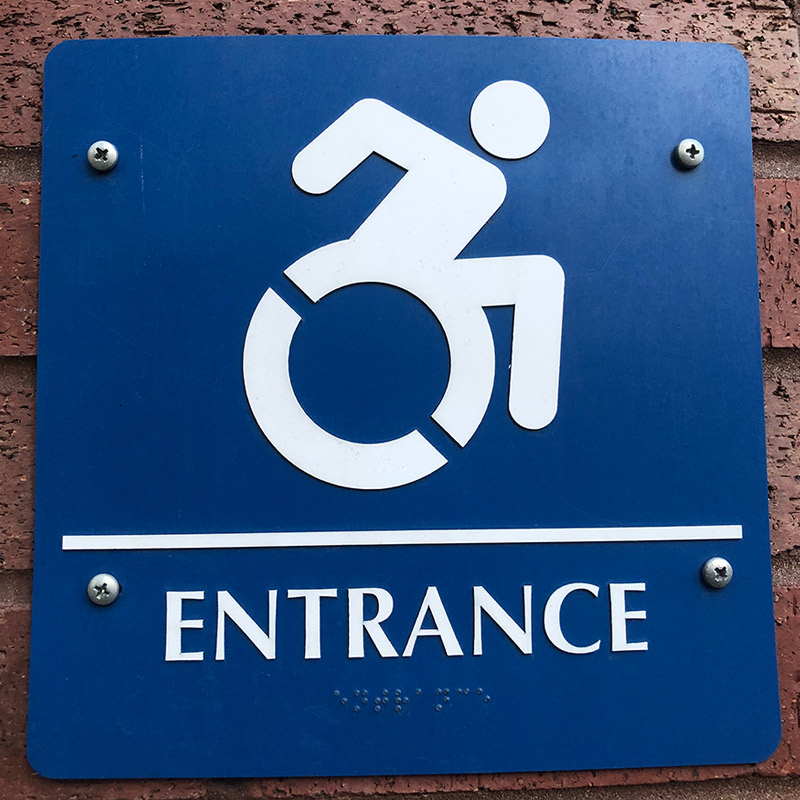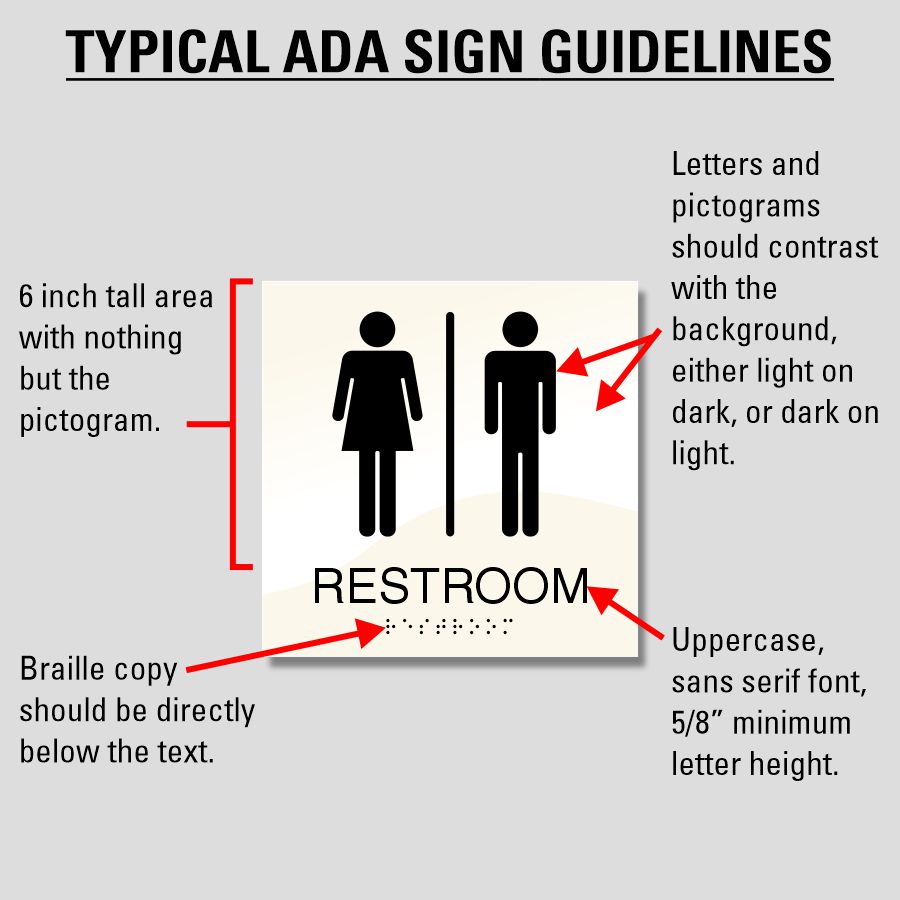The Function of ADA Signs in Complying with Availability Criteria
The Function of ADA Signs in Complying with Availability Criteria
Blog Article
Discovering the Secret Functions of ADA Indications for Improved Ease Of Access
In the realm of accessibility, ADA signs work as quiet yet powerful allies, guaranteeing that spaces are inclusive and navigable for people with specials needs. By integrating Braille and tactile components, these indicators break barriers for the aesthetically impaired, while high-contrast color design and readable fonts deal with diverse visual demands. Their calculated placement is not approximate however instead a calculated effort to promote seamless navigating. Past these attributes exists a deeper story regarding the advancement of inclusivity and the continuous dedication to creating fair spaces. What a lot more could these signs indicate in our pursuit of global accessibility?
Value of ADA Conformity
Ensuring conformity with the Americans with Disabilities Act (ADA) is critical for fostering inclusivity and equal gain access to in public rooms and workplaces. The ADA, passed in 1990, mandates that all public centers, companies, and transport services suit people with impairments, ensuring they take pleasure in the very same legal rights and opportunities as others. Conformity with ADA standards not just meets lawful obligations however likewise improves a company's online reputation by showing its dedication to variety and inclusivity.
One of the vital elements of ADA compliance is the implementation of obtainable signs. ADA signs are designed to make certain that individuals with disabilities can conveniently navigate through structures and areas.
Furthermore, sticking to ADA guidelines can reduce the threat of legal repercussions and potential penalties. Organizations that fall short to adhere to ADA standards may encounter charges or lawsuits, which can be both harmful and monetarily troublesome to their public photo. Thus, ADA conformity is integral to promoting a fair atmosphere for every person.
Braille and Tactile Elements
The incorporation of Braille and tactile aspects right into ADA signage embodies the principles of ease of access and inclusivity. It is usually positioned beneath the corresponding text on signs to make certain that people can access the details without aesthetic assistance.
Tactile elements expand past Braille and include raised characters and icons. These elements are developed to be noticeable by touch, enabling individuals to identify room numbers, restrooms, leaves, and various other essential locations. The ADA sets particular guidelines pertaining to the dimension, spacing, and placement of these responsive components to enhance readability and ensure uniformity across various settings.

High-Contrast Color Plans
High-contrast color design play a critical role in enhancing the presence and readability of ADA signage for people with aesthetic impairments. These systems are necessary as they make best use of the difference in light reflectance in between text and history, ensuring that signs are conveniently noticeable, also from a distance. The Americans with Disabilities Act (ADA) mandates using specific shade contrasts to accommodate those with restricted vision, making it an important facet of compliance.
The efficiency of high-contrast colors hinges on their capacity to stand apart in numerous lighting conditions, consisting of dimly lit atmospheres and locations with glare. Normally, dark message on a light history or light text on a dark history is employed to accomplish ideal comparison. For example, black text on a yellow or white history offers a plain aesthetic distinction that aids in quick acknowledgment and comprehension.

Legible Fonts and Text Size
When thinking about the layout of ADA signs, the selection of legible fonts and suitable text size can not be overstated. These elements are vital for guaranteeing that indications come to people with aesthetic disabilities. The Americans with Disabilities Act (ADA) mandates that typefaces should be not italic and sans-serif, oblique, script, very ornamental, or of unusual type. These needs help guarantee that the text is easily readable from a distance which the personalities are distinct to varied audiences.
According to ADA standards, the minimum message height must be 5/8 inch, and it should raise proportionally with seeing range. Consistency in message size adds to a cohesive visual experience, aiding individuals in browsing environments effectively.
Moreover, spacing between letters and lines is essential to legibility. Ample spacing avoids characters from appearing crowded, boosting readability. By adhering to these requirements, developers can considerably boost ease of access, making certain that signage serves its desired purpose for all individuals, despite their visual abilities.
Reliable Placement Techniques
Strategic positioning of ADA signs is essential for optimizing accessibility and guaranteeing conformity with lawful standards. Correctly positioned indications lead individuals with impairments efficiently, assisting in navigating in public rooms. Secret considerations consist of distance, height, and presence. ADA guidelines stipulate that signs should be mounted at a height between 48 to 60 inches from the ground to guarantee they are within the line of view for both standing and seated people. This typical elevation array is essential for inclusivity, making it possible for mobility device individuals and individuals of varying heights to access details easily.
Additionally, indicators have to be positioned nearby to the lock side of doors to enable simple identification prior to entrance. Uniformity in sign positioning throughout a facility boosts predictability, decreasing complication and boosting see overall customer experience.

Final Thought
ADA indicators play a crucial duty in promoting availability by incorporating functions that resolve the demands of individuals with impairments. Incorporating Braille and responsive components makes certain critical information comes to the click this visually damaged, while high-contrast color design and understandable sans-serif font styles enhance presence throughout different illumination conditions. Reliable placement strategies, such as suitable mounting elevations and tactical locations, further facilitate navigation. These aspects jointly foster an inclusive atmosphere, emphasizing the value of ADA compliance in making sure equal gain access to for all.
In the realm of availability, ADA indicators offer as quiet yet effective allies, making certain that spaces are comprehensive and accessible for individuals with impairments. The ADA, passed in 1990, mandates that all public facilities, companies, and transportation services suit people with impairments, ensuring they take pleasure in the exact same rights and opportunities as others. ADA Signs. ADA signs are designed to guarantee that individuals with handicaps can conveniently browse with rooms and structures. ADA standards specify that indicators ought to be installed at a height between 48 to 60 inches from the ground to ensure they are within the line of sight for both standing and seated people.ADA indicators play an essential function in promoting accessibility by incorporating functions that address the requirements use this link of people with specials needs
Report this page